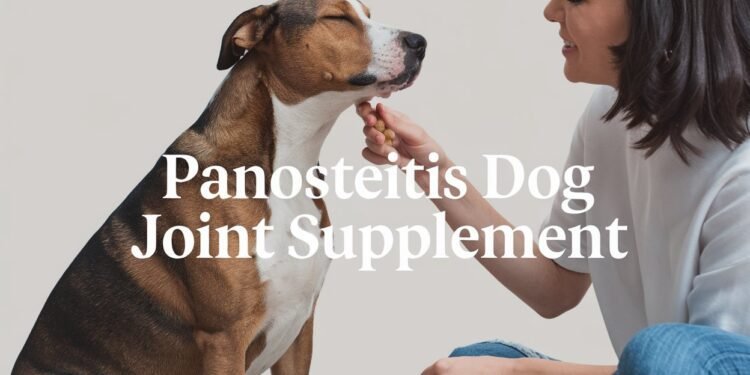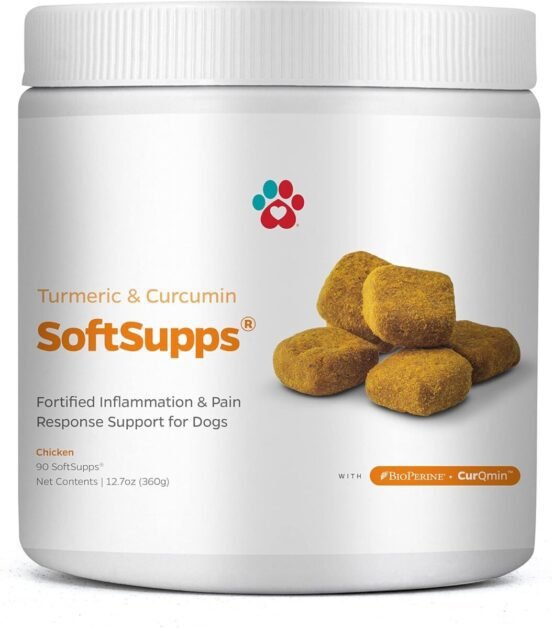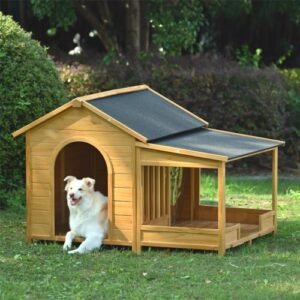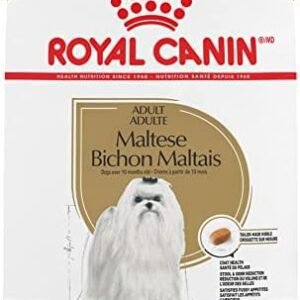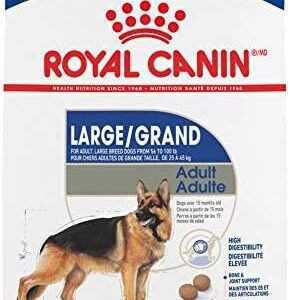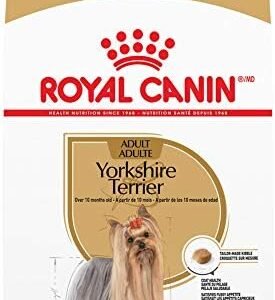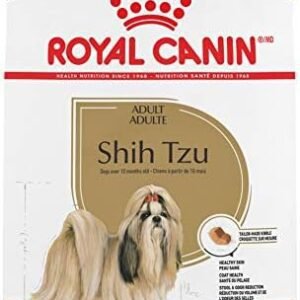Did you know that panosteitis can hit dogs as young as 2 months old? It can last until they are 18-24 months old. This painful condition mostly affects big dogs and hits boys more than girls. It’s important to manage the pain to keep dogs comfortable and happy.
Key Takeaways
- Panosteitis is a painful condition that affects the long bones of the legs in young, growing dogs.
- Larger dog breeds, such as German Shepherds, Great Danes, and Rottweilers, are more prone to panosteitis.
- Pain management is a crucial aspect of treating panosteitis to ensure the dog’s comfort and well-being.
- Supplements containing ingredients like glucosamine, chondroitin, and omega-3 fatty acids can support joint health in dogs with panosteitis.
- Maintaining a healthy weight and providing a balanced diet are important preventive measures for panosteitis.
Table of Contents
Understanding Panosteitis in Dogs
Panosteitis is a common issue in young, fast-growing dogs, especially in larger breeds. It’s also known as “growing pains.” This condition causes inflammation in the long bones of a dog’s legs. It leads to sudden, unexplained lameness, which can be hard on both dogs and their owners.
What is Panosteitis?
This condition usually hits dogs during their growth spurts, between 5 and 18 months old. The exact cause is still a mystery, but genetics, stress, infection, metabolism, and nutrition might be involved. Even though it might go away on its own, seeing a vet is key to help with pain and keep your dog’s joints healthy.
Which Dogs Are Affected?
- Larger dog breeds, such as Rottweilers, Great Danes, Basset Hounds, Labrador Retrievers, and German Shepherds, are more prone to panosteitis.
- Male dogs tend to be more commonly affected than females, though both genders can develop the condition.
Causes and Symptoms
The exact reasons for panosteitis in dogs are still unknown. But genetics, infection, stress, metabolism, and nutrition might play a part. The main sign is sudden, painful lameness in one or more legs. This can also cause fever, loss of appetite, and weight loss.
“Panosteitis can be a frustrating condition for pet owners, but with proper management and support, dogs can overcome the discomfort and regain their active, healthy lifestyles.”
Understanding panosteitis helps pet owners work with their vets to manage the condition. This ensures their dogs can stay healthy and active.
Importance of Pain Management
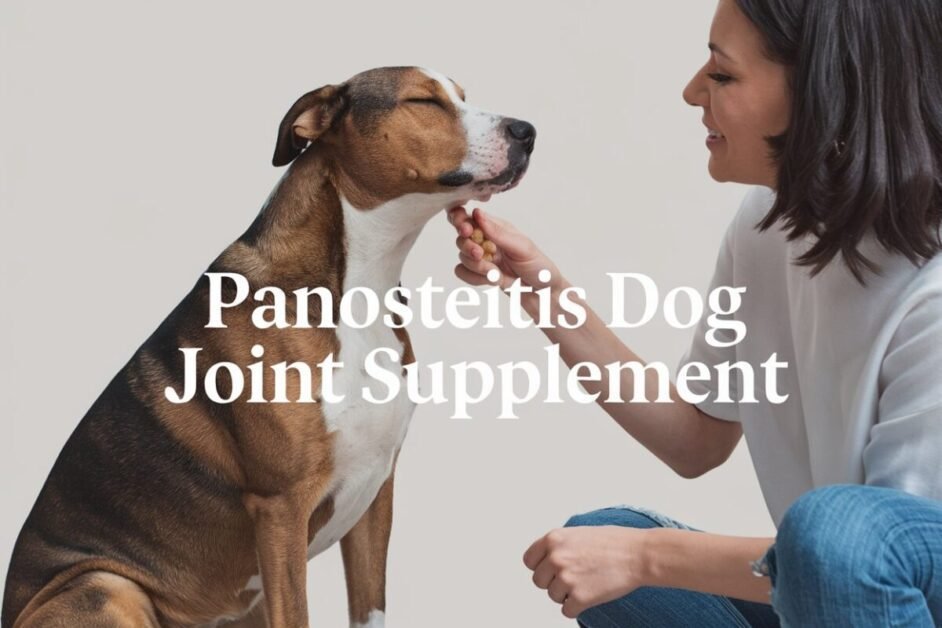
Managing panosteitis is key for pain relief in dogs. This condition is very painful for dogs, causing them to limp and lose their quality of life. Giving panosteitis pain relief for dogs with pain meds and anti-inflammatory drugs is vital.
When panosteitis flares up, dogs feel a lot of pain in their legs. Managing dog joint pain is crucial to make them feel better. It helps them stay comfortable and mobile, so they can keep doing what they love.
To help dogs with panosteitis, vets may use painkillers like NSAIDs or other drugs. It’s important to work with your vet to find the right pain plan for your dog. This ensures they stay comfortable while they get better.
“Alleviating pain and discomfort should be the primary goal when treating panosteitis in dogs. This not only improves their quality of life but also supports the healing process.”
By focusing on panosteitis pain relief for dogs and managing dog joint pain, you can make life easier for your dog. Adding pain management to their treatment plan is key to caring for dogs with panosteitis.
Diagnosing Panosteitis in Dogs
To diagnose panosteitis in dogs, a vet must do a detailed check-up. This includes both physical checks and tests like X-rays.
Physical Examination
The vet will feel the affected bones during the check-up. They look for pain and swelling. Panosteitis makes dogs uncomfortable when the vet presses on bones like the radius, ulna, or femur.
The vet also checks for other signs like fever, less appetite, or changes in how the dog walks.
X-Ray and Other Tests
X-rays are key to confirm panosteitis. They show changes in bone density, but these might not be seen for up to 10 days after the dog starts limping. Sometimes, the vet might suggest blood tests to check for inflammation.
| Diagnostic Tool | Purpose |
|---|---|
| Physical Examination | Assessing pain and swelling in affected bones |
| X-Rays | Identifying changes in bone density |
| Blood Tests | Checking for signs of inflammation |
By using physical checks and X-rays, vets can spot panosteitis in dogs. They can then make a treatment plan.
Treating Panosteitis with Joint Supplements
Panosteitis is a tough condition in dogs, but joint supplements can help. They offer support and pain relief when dogs are lame. These supplements have ingredients that address the root causes of panosteitis. This helps ease pain and improve joint health.
Key Ingredients for Joint Support
Good joint supplements for panosteitis have ingredients that help with joint function and mobility. Some key components are:
- Chondroitin sulfate: This helps keep joints lubricated, which reduces wear on the cartilage.
- Glucosamine: It’s a building block for healthy cartilage, helping repair and regenerate it.
- Omega-3 fatty acids: These are anti-inflammatory and can lessen swelling and pain from panosteitis.
panosteitis dog joint supplement Benefits
With these ingredients, joint supplements for panosteitis in dogs offer many benefits:
- They make joints more lubricated and reduce friction, making movement less painful.
- They help repair and regenerate cartilage, supporting long-term joint health.
- They lessen inflammation and pain, offering relief during panosteitis episodes.
- They increase mobility and range of motion, letting dogs stay active and comfortable.
Joint supplements can be a big help in managing panosteitis in dogs. They work well with other treatments to keep joints working well during this tough condition.
Dietary Considerations for Panosteitis
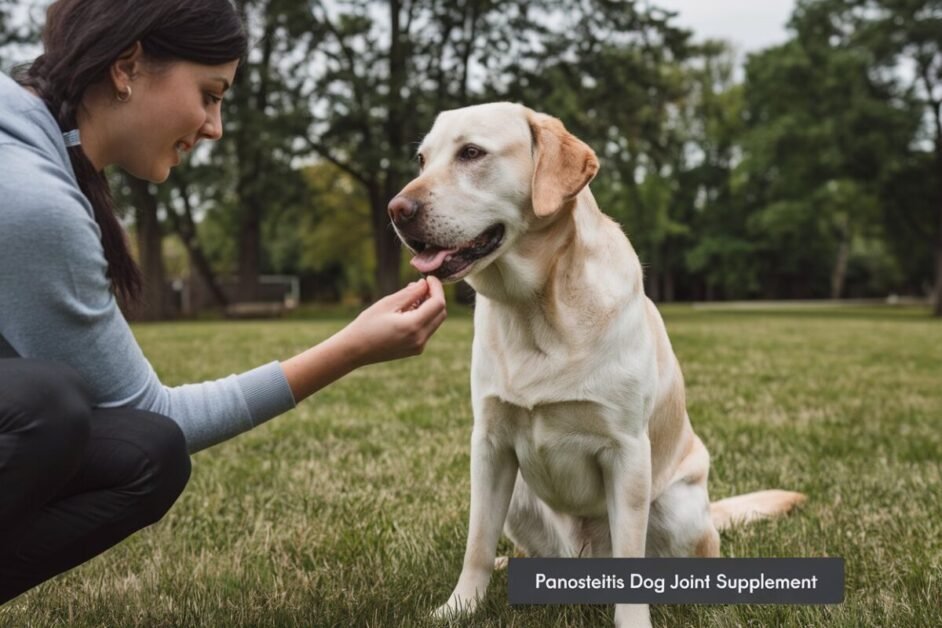
Feeding your dog right is key to managing panosteitis, a painful joint issue in large and giant breed dogs. It’s vital to feed them a diet made for large breed puppies or teens. This diet supports healthy bones and joints.
Balanced Nutrition for Growing Dogs
Don’t give adult dog food to growing dogs. It lacks the protein, calcium, and energy they need. Talk to your vet about the best diet and how much to feed your pup. This helps keep them at a healthy weight and reduces panosteitis symptoms.
The Precise Holistic Complete Large/Giant Breed Puppy Food is a great choice. It has 23% protein and 12% fat for slow, healthy growth. Adding the Core 4 Kit #5 boosts your dog’s nutrition and joint health.
You can also add holistic canned foods, dehydrated raw diets, and some human foods like yogurt, berries, and veggies. This variety makes your dog’s diet rich and balanced, helping with panosteitis.
“Transitioning to a new diet may help prevent further issues, with attention to appropriate protein, calcium, and phosphorous balance.”
Always talk to your vet before changing your dog’s diet or adding new supplements. A balanced diet can support your dog’s health during this tough time.
Complementary Therapies for Panosteitis
Traditional treatments like pain meds and joint supplements are key for panosteitis in dogs. But, adding complementary therapies can also help. These holistic remedies can lessen inflammation, boost mobility, and support joint health. They offer a full approach to caring for dogs with this issue.
Physical therapy is a great option for panosteitis. It includes exercises, stretches, and low-impact activities. These help strengthen muscles and improve how well joints move. Hydrotherapy, or underwater treadmill therapy, is also great. It reduces joint stress while still offering exercise benefits.
Acupuncture is another treatment that helps with panosteitis. It targets specific body points to manage pain and lessen inflammation. This natural pain relief can be a big help in a dog’s care plan.
Massage therapy is also good for dogs with panosteitis. Gentle massage boosts blood flow, cuts muscle tension, and makes joints feel better. It can be part of a dog’s regular care.
Natural anti-inflammatory compounds like omega-3 fatty acids and antioxidants can also support dogs with panosteitis. These supplements help reduce inflammation and support joint health. They work well with other treatments.
By using a mix of complementary therapies, pet owners can make a more complete plan for their dogs with panosteitis. This approach helps ease pain and supports long-term joint health.
| Complementary Therapy | Potential Benefits |
|---|---|
| Physical Therapy | Strengthens muscles, improves range of motion, and reduces joint stress |
| Acupuncture | Regulates pain signals, reduces inflammation, and provides natural pain management |
| Massage Therapy | Improves blood flow, reduces muscle tension, and eases joint discomfort |
| Omega-3 Fatty Acids and Antioxidants | Reduce inflammation and support overall joint health |
Preventing Panosteitis in Large Breed Dogs
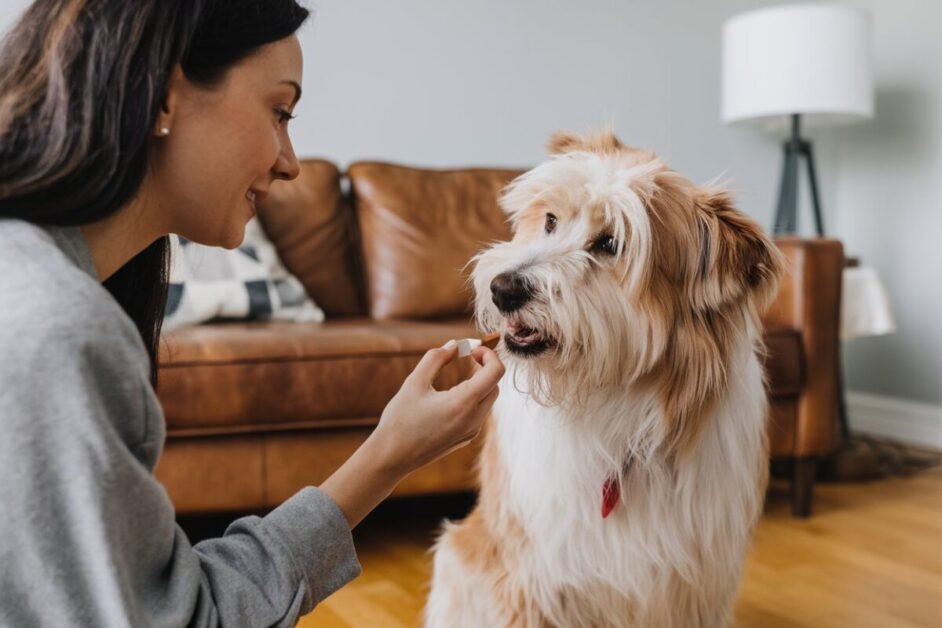
Panosteitis is a common issue in large and giant breed dogs. It can be very painful for them. But, we can prevent or lessen its effects. We should focus on nutrition and how much exercise they get.
Nutritional Strategies
Feeding large breed puppies the right food is key. These diets support their fast growth and help their bones and joints grow strong. Keeping them at a healthy weight also helps by easing the stress on their bones and joints.
Exercise and Weight Management
How much exercise is right can help prevent panosteitis. Too much jumping or running can hurt their growing bones and joints. Instead, try walking on a leash, swimming, or playing gently.
By doing these things, we can help prevent panosteitis in dogs. This also supports the long-term care of our large breed puppies.
| Nutritional Considerations | Exercise and Weight Management |
|---|---|
|
|
By using these strategies, we can help stop or lessen panosteitis in large breed dogs. This keeps their joints healthy and happy.
Signs of Joint Health Issues in Dogs
Keeping your dog’s joints healthy is key, especially for big breeds that often face joint issues. Signs like sudden lameness can show a problem. Watching how your dog moves and any changes can help spot joint issues early and get the right vet care.
Some common signs of joint health issues in dogs include:
- Stiffness, especially when getting up or lying down
- Difficulty standing up or lying down
- Reluctance to exercise or engage in physical activities
- Pain or sensitivity when the joints are touched or manipulated
These dog joint health symptoms could mean many joint problems, like arthritis or hip dysplasia. Watching your dog’s moves and any changes in their behavior can help spot signs of joint problems in large breed dogs early. This lets you work with your vet for the best care.
| Common Joint Health Issues in Dogs | Symptoms |
|---|---|
| Arthritis | Stiffness, decreased activity, difficulty standing up or lying down |
| Hip Dysplasia | Swaying ‘bunny hop’ gait, decreased range of motion, pain |
| Elbow Dysplasia | Lameness, stiffness, swelling in the elbow joint |
| Osteochondrosis Dissecans (OCD) | Lameness, joint pain, decreased range of motion |
| Legg-Calve-Perthes Disease | Gradual worsening of symptoms, refusal to bear weight on affected leg |
By keeping an eye out and recognizing signs of joint problems in large breed dogs, you can work with your vet. Together, you can manage dog joint health symptoms and help your dog stay well.
Combining Joint Supplements with Other Treatments
Joint supplements can really help dogs with panosteitis, but they work best with other treatments. Using joint supplements with pain meds, anti-inflammatory drugs, physical therapy, and other therapies helps tackle panosteitis from all angles. This approach reduces inflammation and pain and supports long-term joint health and mobility.
Studies show that curcumin in turmeric helps with joint pain and inflammation. For dogs, about 15 to 20 mg of turmeric per pound of body weight is a good dose. Boswellia serrata resin is another natural anti-inflammatory good for dogs. A 50-pound dog should start with 300 mg twice a day and then take half that amount for maintenance.
Cinnamon can also help dogs with irritable bowel disease and joint pain. For a 50-pound dog, add 1/4 teaspoon of cinnamon to their food twice a day for two weeks. Hawthorn can help stabilize collagen in joints and improve circulation, easing arthritis pain in dogs. But, be careful as it can affect dogs with heart disease.
Using joint supplements with other proven treatments makes a complete plan for your dog’s joint health. Talk to your vet to find the best plan for your dog with panosteitis.
“An integrative approach that combines joint supplements with other treatments can provide comprehensive support for dogs with panosteitis.”
Natural Alternatives for Canine Joint Support
Natural supplements can be a great choice for supporting your dog’s joint health. They offer a holistic way to help your pet, with fewer side effects. These supplements are an alternative to traditional ones.
Some natural supplements for dogs have shown great results in supporting joint function and mobility. These include:
- Turmeric – This powerful anti-inflammatory herb has been used for centuries to manage joint pain and stiffness.
- Green-lipped mussel – Rich in omega-3 fatty acids, this marine extract can help reduce inflammation and promote joint lubrication.
- Boswellia – An ancient Ayurvedic herb, boswellia contains compounds that may inhibit enzymes responsible for joint destruction.
These natural compounds help address the root causes of joint problems. They work on inflammation and cartilage deterioration. When used with a balanced diet and exercise, they can be very effective in supporting your dog’s joint health and mobility.
Always talk to your vet before starting any supplements, including natural ones. This ensures they are safe and right for your dog. By choosing these holistic options, you can help your dog stay active and comfortable.
| Natural Ingredient | Key Benefits for Canine Joint Health |
|---|---|
| Turmeric | Potent anti-inflammatory properties, may reduce joint pain and stiffness |
| Green-lipped Mussel | Rich in omega-3s, helps lubricate joints and decrease inflammation |
| Boswellia | Contains compounds that may inhibit enzymes responsible for joint damage |
Reputable Panosteitis Dog Joint Supplement Products
Choosing a panosteitis dog joint supplement means picking a trusted brand with top-notch ingredients. Look for products like Pet Parents® Hip and Joint SoftSupps®. They have ingredients like chondroitin sulfate, glucosamine, and yucca schidigera extract. These help with joint health and mobility in dogs. Always talk to your vet to find the best supplement for your dog’s needs.
Panosteitis can happen to any dog, but it’s more common in puppies and young adult dogs. Big breeds like Rottweilers, Great Danes, and German Shepherds are at higher risk. The best way to treat it is to wait until the dog grows out of it. Sometimes, panosteitis in dogs can just go away on its own.
Using supplements with Chondroitin Sulfate, Yucca Schidigera Extract, and Vitamin C can help dogs with panosteitis. High-quality joint supplements can boost their nutrition and help them recover faster. Your vet can give you advice on how to prevent panosteitis. Also, feeding your dog the right amount can keep them from getting too heavy, which lowers the risk of panosteitis.
| Product | Key Ingredients | Benefits |
|---|---|---|
| Pet Parents® Hip and Joint SoftSupps® | Chondroitin Sulfate, Glucosamine, Yucca Schidigera Extract | Supports canine joint health and mobility |
For the best joint supplements for large breed dogs, pick a product made for their needs. These dogs are more likely to get panosteitis and other joint problems. Using supplements with proven ingredients can help keep their joints healthy and happy.
“Providing the right joint support supplements can make a significant difference in a dog’s recovery and long-term joint health, especially for those breeds more susceptible to conditions like panosteitis.”
Monitoring Your Dog’s Joint Health
Watching your dog’s joint health closely is very important, especially for big breeds like panosteitis. Look for signs like stiffness, trouble moving, not wanting to exercise, and being sensitive or painful when you touch their joints. If you see any changes in how they act or move, talk to your vet right away. Catching joint problems early can make your dog more comfortable and improve their life.
Panosteitis usually goes away by the time a dog is two years old. But, it’s still important to keep an eye on your dog’s joints to make sure they stay healthy and don’t hurt. Big breeds like German Shepherds, Great Danes, Labrador Retrievers, and Basset Hounds often get this condition between 5 and 18 months old. Keeping an eye on your dog’s joint health is key to managing this and keeping them happy and active.
| Product | Recommendation | Key Features |
|---|---|---|
| Nutramax Dasuquin Soft Chews With MSM | Top Pick for Canine Joint Health | Contains glucosamine, chondroitin, and MSM to support joint function |
| Natural Dog Company Hip & Joint | Natural Pick for Joint Supplements | Formulated with organic, plant-based ingredients to promote joint health |
| Premium Care Hemp Mobility Chews | Best All-Organic Choice | Combines hemp, glucosamine, and chondroitin for comprehensive joint support |
| Native Pet Relief Supplement for Dogs | Limited-Ingredient Pick | Features a clean, minimalist formula to target joint health and mobility |
| Front of the Pack Move | Best Powder Supplement | Easily mixable powder fortified with joint-supporting nutrients |
| K9 Vegetarian Glucosamine | Vegetarian Choice for Joint Health | Vegetable-derived glucosamine and chondroitin for plant-based joint support |
By keeping a close eye on your dog’s joint health and acting fast if you see problems, you can help them stay comfortable and mobile. Remember, catching issues early is crucial for managing conditions like panosteitis. So, don’t wait to talk to your vet if you have any worries.
Conclusion
Panosteitis is a painful condition that affects young, growing dogs, especially big breeds. It happens in their long bones. The exact cause is still a mystery, but managing pain is key to keeping your dog comfortable. Using joint supplements, a balanced diet, and other therapies helps a lot.
Working with your vet and using a full treatment plan is important. Keeping an eye on your dog’s joints and how they move is also key. Panosteitis can come back as your dog grows. With the right care, your dog can still live a happy and active life.
Panosteitis is common in big dogs, but you can help your dog feel better with the right treatment. Being proactive and caring for your pet’s needs is crucial. This way, your dog can get through this tough time of growing up feeling good.

















